Climate Change at the Poles

At the ends of the Earth, life thrives despite extreme conditions. In the Arctic and Southern Oceans, organisms have evolved adaptations to cope with year-round cold and six months of darkness. But the tough critters living in these harsh climates belie the delicate balance that holds the ecosystem together—a balance that human activities are disrupting in alarming ways.
Among the biggest threats to the poles is rapid climate change. Atmospheric carbon dioxide has been rising for more than a century, with hefty contributions from the fossil fuels used to power our homes, businesses, and cars. The increasingly dense blanket of greenhouse gases is trapping heat and taking its toll on the planet, especially at the poles. Global temperatures have increased since the 1800s with models predicting their continued rise, and sea ice has been decreasing in extent and thickness. By 2040, Arctic sea ice may disappear altogether during summer months.
The warming of polar oceans has powerful implications for organisms living there—and for us. Polar sea ice helps regulate Earth's climate. White ice reflects more of the Sun's energy back into space than does dark water. Without sea ice, Earth would absorb more solar radiation—and our climate would be even warmer.
Many animals also depend directly on sea ice. Polar bears, for instance, hunt seals from the ice and gain most of their weight in winter. But with ice declining and breaking up earlier, bears have less time to hunt. Because their habitat is melting, the bears were listed as a threatened species under the Endangered Species Act in May of 2008. Pacific walruses, which usually plow a large area of the ocean floor while looking for clams and other prey, have started congregating near the shore and on land because the sea ice is beyond their reach. Ringed seals, ivory gulls, and ice algae are just some of the other species that rely on the ice to survive.
In polar waters, tiny swimming snails called pteropods will feel the changes in another way. In addition to warming, the ocean is becoming more acidic as it absorbs more carbon dioxide from the air. Scientists predict that during this century, parts of the Southern Ocean will be so acidic that the shells of pteropods and other organisms will begin dissolving. Since they are an essential food source for larger animals such as herring, cod, and, and baleen whales, the problems pteropods face could disrupt the entire ecosystem. Their plight also spells trouble for corals and other marine animals that build their shells or skeletons from calcium.
Other species, such as caribou, are changing their migration patterns and ranges as seasons and weather patterns shift. For people who live near the poles, like the Inuvialuit people of Sachs Harbour, Canada, weather and hunting grounds are becoming more unpredictable. Knowledge of the environment that has served generations is being defied by a changing climate. Many northern communities have also observed coastal erosion and watched the permafrost—ground that is frozen most of the year—melting and buckling under their homes and roads. While not common, some communities like Kivalina and Shishmaref, both in Alaska, are planning to entirely relocate, with costs in the hundreds of millions of dollars.


